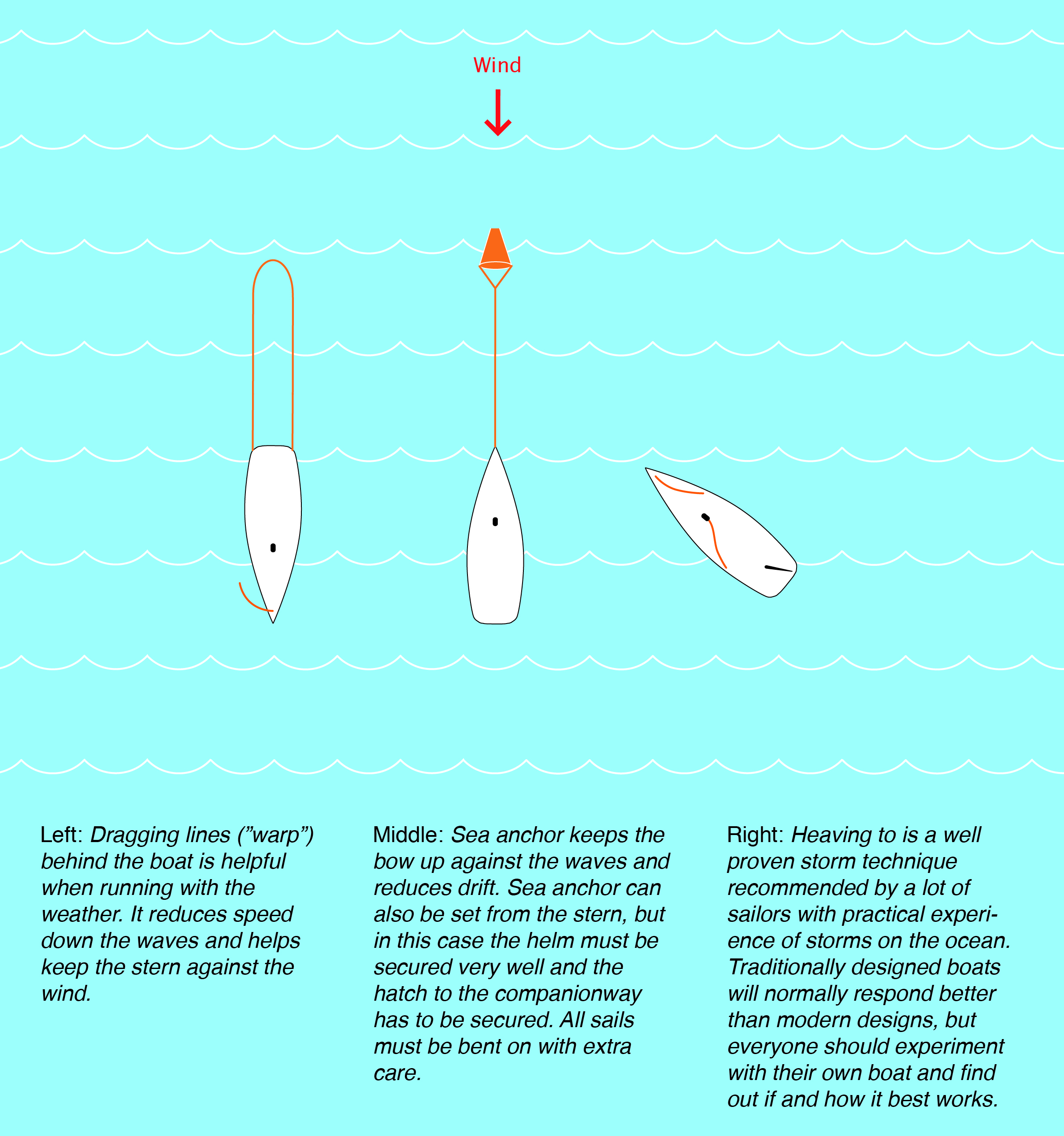Storm Strategy
Book Extract
The single most important thing you can do for safety when it comes to storms at sea, is not to be on the water at all when the weather gets really bad. Of course, in spite of good intentions you can find yourself at sea in weather you would not have chosen to be out in. Here are some thoughts on how to handle that situation with regard to STORM STRATEGY
Sailing with the wind and sea on the beam is not a good idea in a storm. But should you point the bow into the wind and put out a sea anchor – or heave to? Or is it better to run with wind and seas, possibly with a small headsail, trailing a rope to slow you down?
Running With The Weather
A lot of seasoned sailors would argue that the best survival strategy for extreme weather is to go with the wind and waves. Sailing with just a small storm jib can be a sensible setup. You could also drop all the sails and sail only on the rig. To run with the weather assumes that there is room enough downwind, however. Experienced sailors are always careful not to sail too close to a lee shore if there is risk of extreme weather. They will either seek shelter before the weather gets bad, or head far out to sea, with plenty of space to sail with the weather – for several days if necessary.
Avoid placing the boat square to the wind and waves. Breaking waves can turn a boat over if it is beam to. In very high seas you should try to limit your speed down the waves. Long, heavy ropes streaming astern can help and can also curb breaking waves to a certain extent.
A risk when running with the wind and waves is that the helmsman eventually will get exhausted and that sooner or later you will experience a violent broach or knock-down. Moreover, you are sailing many miles in a direction that is not necessarily a good one.
Still, to sail with the weather will be the easiest choice and could be the right decision also in less dramatic circumstances. Even if the situation may not be dangerous, it will often be a good idea to turn around and sail back with the wind or change the destination to somewhere downwind.
Heaving To
Heaving to is an old, traditional way to survive harsh weather. Modern boats are not always designed and balanced in a way that makes the technique suitable and the method is rarely used these days. But especially with a traditional, long-keeled boat it may be relevant to heave to and wait for better weather. You should try it out in controlled conditions, to know how your boat reacts.
This is how it is done: When the boat is sailing close-hauled (upwind) you initiate a normal tack but leave the jib sheet attached so that the jib is backed. The mainsheet is loosened and adjusted so the boat balances, but without the mainsail contributing much to forward progress. The rudder is hard over, steering the boat into the wind. The backed jib now forces the boat to leeward, while the helm pushes the boat to windward.
The idea is that these two forces will counteract each other and keep the boat in balance. When this works as intended, the boat should be in balance, with the bow pointing in a 45 degree angle towards the waves and wind, with hardly any speed ahead, but also without drifting much. The boat will now deal with the waves relatively well. The rudder may be locked in this position, so the whole crew can theoretically remain below deck until the weather improves, maintaining a proper lookout. In extreme weather, the boat might be knocked down by the forces in the backed headsail, but nevertheless, many have safely weathered a storm this way.
Sea Anchor
A drogue or sea anchor helps to keep the bow towards the waves. The rope should be long and with stretch and the sea anchor should preferably be in step with the waves, so the boat and drogue are on top of a wave at the same time.

4 Tips For Safety In Rough Weather
- Stay on board. In other words: Hold on! Be aware and take care when you move about on deck. Use a harness when conditions demand it.
- Use a life vest, preferably one with a personal emergency beacon, so that you can easily be found if you should fall in the water.
- Be aware of the boom when the boat sails downwind, especially in high seas. Use a preventer, make sure the helmsman is focused and that the crew knows what an involuntary gybe is. Avoid a dead downwind run, especially with any kind of mainsail up.
- Check if the boat is taking on water, either through leaky or defective through-hull fittings, piping systems, deck hatches or elsewhere. Don’t forget to concentrate on navigation!
© Not to be reproduced without written permission from Fernhurst Books Limited.
Sail and Rig - The Tuning Guide by Magne Klann & Øyvind Bordal.
Magne Klann has always had a passionate relationship with life at sea. After sailing in the Norwegian and Swedish archipelago as a child, he has raced dinghies and worked as a sailmaker. Magne is a photographer and writer, educated in visual communication in England. Together with Øyvind Bordal, he has published several books on sailing in Scandinavia, all of them read widely in the sailing community.
Øyvind Bordal has been sailing from childhood; dinghy racing, coaching, singlehanded / doublehanded racing and later cruising as a skipper on the open ocean, logging thousands of nautical miles including several Atlantic crossings. As a journalist / writer he has written stories for sailing magazines in many European countries, as well as a series of books on sailing with Magne Klann.